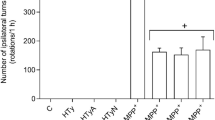Abstract
We present the results of an in vitro investigation of the inhibitory effects of phenylpropanoid metabolites on copper-induced protein oxidative modification of mice brain homogenate. The effects of caffeic acid, 3-(3, 4-dihydroxyphenyl)-l-alanine, esculetin, ferulic acid, and scopoletin were stronger than that of mannitol as a free-radical scavenger, whereas the effects of other phenylpropanoid metabolites, cinnamic acid, coniferyl alcohol, p-coumaric acid, coumarin, phenylalanine, tyrosine, and umbelliferone, were weak. These results demonstrated that phenolic carboxylic acids with 3,4-dihydroxy or 4-hydroxy-3-methoxy substituents and benzo-α-pyrons with 6,7-dihydroxy or 7-hydroxy-6-methoxy substituents in phenylpropanoid metabolites inhibit metal-induced protein oxidative modification of the brain.
Similar content being viewed by others
References
B. Halvorsen, I. Brude, C. A. Drevon, J. Nysom, L. Ose, E. N. Christiansen, et al., Effect of homocysteine on copper ion-catalyzed, azo compound-initiated, and mononuclear cell-mediated oxidative modification of low density lipoprotein, J. Lipid Res. 37, 1591–1600 (1996).
H. Ogihara, T. Ogihara, M. Miki, H. Yasuda, and M. Mino, Plasma copper and antioxidant status in Wilson’s disease, Pediat. Res. 37, 219–226 (1995).
A. I. Bush and L. E. Goldstein, Specific metal-catalysed protein oxidation reaction in chronic degenerative disorders of ageing: foucus on Alzheimer’s disease and age-related cataracts, Novartis Found. Symp. 235, 26–43 (2001).
V. Seidal, H. Verholle, Y. Malard, F. Tillequin, J. C. Fruchart, P. Duriez, et al., Phenylpropanoids from Ballota nigra L. inhibit in vitro LDL peroxidation, Phytother. Res. 14, 93–98 (2000).
O. H. Lowry, N. J. Rosenbrough, A. L. Farr, and R. J. Randall, Protein measurement with folin phenol reagent, J. Biol. Chem. 193, 265–275 (1951).
G. L. Ellman, Tissue sulfhydryl group, Arch. Biochem. Biophys. 82, 70–77 (1959).
S. Toda and Y. Shirataki, Inhibitory effects of sophoraflavanones B and H in Sophora mooracroftiana Beth ex Baker on copper-ion-induced protein oxidative modification of mice brain homogenate in vitro, Biol. Trace Element Res. 78, 157–162 (2000).
S. Toda and Y. Shirataki, Comparisons of antioxidative and chelating effects of daidzein and daidzin on protein oxidative modification by copper in vitro. Biol. Trace Element Res. 79, 83–89 (2001).
N. A. Carbonneau, C. L. Leger, L. Monnier, C. Bonnet, F. Michel, G. Fouret, et al., Supplementation with wine phenolic compounds inceases the antioxidant capacity of plasma and vitamin E of low-density lipoprotein without changing the lipoprotein Cu(2+)-oxidizability: possible explantation by phenolic location, Eur. J. Clin. Nutr. 51, 682–690 (1997).
H. R. Griffiths, Antioxidants and protein oxidation. Free Radical Res. 33(Suppl.), S47-S58 (2000).
W. L. Lin, C. J. Wang, Y. Y. Tsai, C. L. Liu, J. H. Hwang, and T. H. Tseng, Inhibitory effect of esculetin on oxidative damage induced by t-butyl hydroperoxide in rat liver, Arch. Toxicol. 74, 467–472 (2000).
M. Nardini, M. D’Aquino, G. Tomassi, V. Gentili, M. Di Felice, and C. Scaccini, Free Radical Biol. Med. 19, 541–552 (1995).
Author information
Authors and Affiliations
Rights and permissions
About this article
Cite this article
Toda, S. Inhibitory effects of phenylpropanoid metabolites on copper-induced protein oxidative modification of mice brain homogenate, in vitro. Biol Trace Elem Res 85, 183–188 (2002). https://doi.org/10.1385/BTER:85:2:183
Received:
Accepted:
Issue Date:
DOI: https://doi.org/10.1385/BTER:85:2:183




